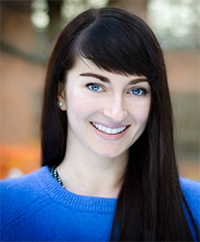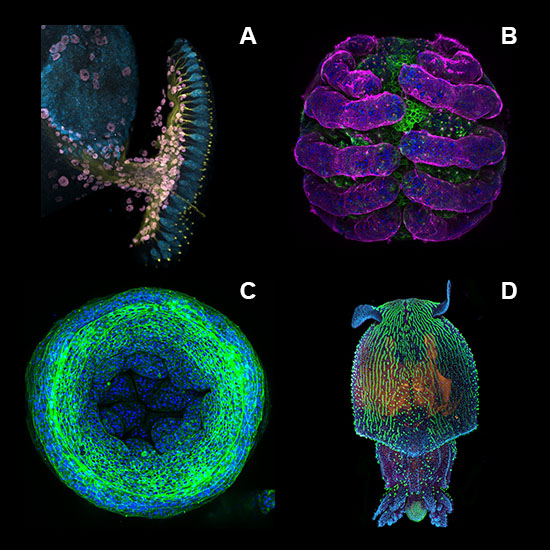2017 Marine Biological
Laboratory Embryology
Course Report
By Tessa Montague
 This summer I was a
student, along with
23 other scientists from around
the world, in the 125th Embryology Course at the
Marine Biological Laboratory (MBL) in Woods Hole,
Massachusetts. The Embryology Course is an intensive
6-week experience, combining morning lectures from
over 40 faculty members with afternoon/evening labs
covering a host of traditional and non-traditional
model organisms. The 2017 Embryology class was a
diverse group of people: the students (consisting of
graduate students, postdocs and a faculty member)
came from a range of disciplines (developmental
biology, computational biology, engineering,
physics…) and from many countries, including Brazil,
Poland, Chile, the USA, the Czech Republic and Sri
Lanka. According to our estimates, we were exposed
to up to 100 different organisms during the course,
ranging from zebrafish to quails, black widow
spiders to squid, and tardigrades to ctenophores.
Each student who entered the course emerged as a
more sophisticated scientific thinker, skilled
microscopist, adroit embryologist and sleep-deprived
human. Most importantly, we left with a group of new
friends and colleagues around the world. This summer I was a
student, along with
23 other scientists from around
the world, in the 125th Embryology Course at the
Marine Biological Laboratory (MBL) in Woods Hole,
Massachusetts. The Embryology Course is an intensive
6-week experience, combining morning lectures from
over 40 faculty members with afternoon/evening labs
covering a host of traditional and non-traditional
model organisms. The 2017 Embryology class was a
diverse group of people: the students (consisting of
graduate students, postdocs and a faculty member)
came from a range of disciplines (developmental
biology, computational biology, engineering,
physics…) and from many countries, including Brazil,
Poland, Chile, the USA, the Czech Republic and Sri
Lanka. According to our estimates, we were exposed
to up to 100 different organisms during the course,
ranging from zebrafish to quails, black widow
spiders to squid, and tardigrades to ctenophores.
Each student who entered the course emerged as a
more sophisticated scientific thinker, skilled
microscopist, adroit embryologist and sleep-deprived
human. Most importantly, we left with a group of new
friends and colleagues around the world.
A day in the life of an embryology
student
Alarms go off at 8 am, we
press snooze a few times, and scramble to get
breakfast in the dining hall before the lecture at
9 am. The first lecture usually consists of an
introduction to the latest organism we’ll be
studying from one of the ~40 outstanding visiting
faculty. Someone knocks over their coffee flask in
the middle of the lecture, which slowly rolls down
the sloped lecture theatre until it thuds at the
bottom.
After our mid-morning break, caffeinated, we
learn in detail about some of the research projects
being conducted in the lecturer’s laboratory.
Questions are saved for the third section of the
morning, affectionately known as the Sweat Box. The
students, course directors and speaker move into the
glass Sweat Box, and for an hour the students quiz
the speaker on what she/he has spoken about until
the PI is a sweaty, quivering mess*.
Students and
faculty break for lunch and return in the afternoon
for the beginning of the day’s lab. Each faculty
member usually stays in Woods Hole for a few days
and brings a graduate student or postdoc to teach us
the art of their organism. At the beginning of the
week we are introduced to the techniques that can be
used in that organism (injection, electroporation,
grafting, CRISPR/Cas9, live imaging,
immunofluorescence, etc.) then later in the week we
are given free reign of the reagents, organisms,
microscopes, Bunsen burners and loudspeakers to do
what we will with. What ensues is an exciting, messy
exploration of science that sometimes results in
breathtaking moments of awe and wonder, and most
other times results in catastrophic failure.
In the
late afternoon, when we’ve squished a few samples,
started some incubations, and squealed at some cute
squid embryos, our course assistants take us out for
softball training. As an international bunch, we
lack sophisticated softball skills (in fact, most of
us lack any softball skills), but we make up for it
with enthusiasm and fear of hurling balls. Why the
softball training? Because at the end of the course
we compete with our archrival, the Physiology
Course, for three highly prized wooden buckets. This
year
Embryology won! Thanks for asking.
Sweaty from the softballs,
we wander into the dining hall for dinner, take a
break to shower or wander around the picturesque New
England town, and return to the lab to work until
the early hours. Some students are natural night
owls; others are early birds, but the energy that
permeates every individual in the course causes us
to work later and later without realizing it.
Sometimes we take a break to go to the local bar
(the Captain Kidd), to swim in the sea, or to get
some much-needed rest, but usually a student is just
about to go to bed when the organism under the
microscope suddenly starts making the most
incredible morphogenetic movements, or (in my case)
the tardigrade starts doing the most incredible
poop, so we stay up, and before we realize it, it’s
the early hours of the morning. This happens 6 days
a week, and on the 7th day we sleep, go to the
beach, eat at Pie in the Sky (the amazing local
bakery), and practice our coordinated fertilization
dance for the
4th of July parade.
The magic of the
Embryology Course is a combination of the people,
the resources and the energy that permeates the MBL.
It’s invigorating to take a break from the
constraints of academic science and be let loose in
a lab full of motivated and crazy people, with a
freezer full of reagents, an incubator full of
organisms, and a basement full of cutting edge
microscopes. We got to ‘play’ as scientists, with
little fear of failure, and we were accompanied on
this journey by a group of equally passionate
faculty, teaching assistants, course directors (Dave
Sherwood and Rich Schneider are amazing!),
microscope specialists and Zeiss interns who were
just as excited about our crazy experiments as we
were.
As graduates of the course, some of us learned
a whole new field; others acquired technical skills
that will be invaluable for the next stage of our
careers, and others found our new model organism.
But for each of us, as we return to our PhDs,
postdocs and labs, we can tap into that energy and
scientific craziness now and well into the future.
*Just kidding!
Tessa Montague is a
graduate student in
Alex Schier’s lab at Harvard
University. You can find her
pooping tardigrade
movie online.
|
 |
|
Images credits: A. Drosophila eye disk.
Bruno C. Vellutini, Zuzana Vavrusova and
Vanessa Knutson. Blue: Elav, Pink: Repo,
Yellow: HRP; B. Spider embryo
(Parasteatoda tepidariorum).
Tessa Montague. Blue: DAPI, Green:
Acetylated Tubulin, Pink: HRP
(autofluorescence); C.
Regenerating hydra. Berta Verd,
Sergio Menchero and Surangi Perera.
Blue: DAPI, Green: Phalloidin;
D. Squid embryo (Doryteuthis pealeii).
Tessa Montague. Blue: DAPI, Green:
Acetylated Tubulin, Orange: Actin, Pink:
Serotonin |
|